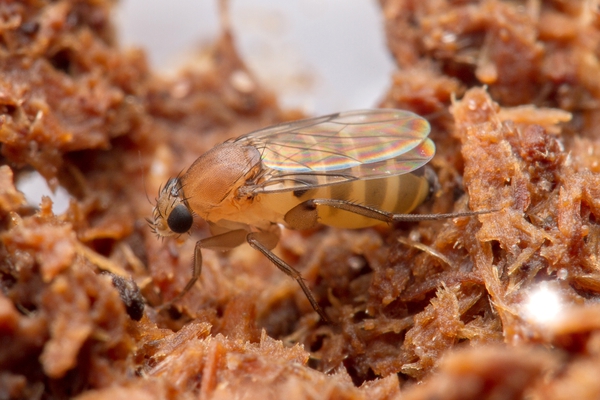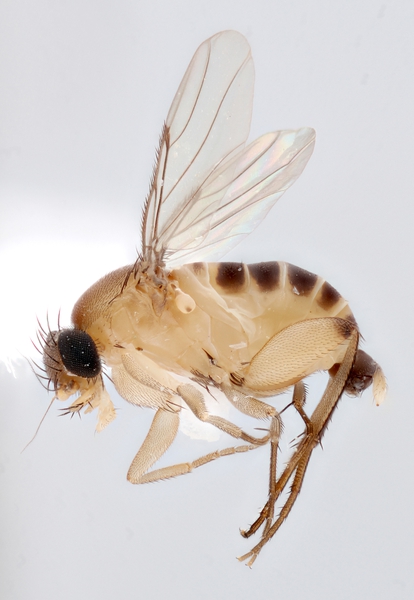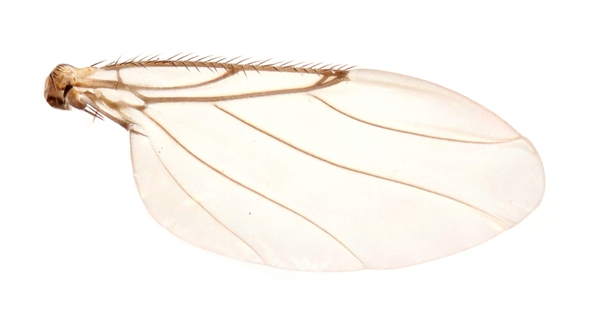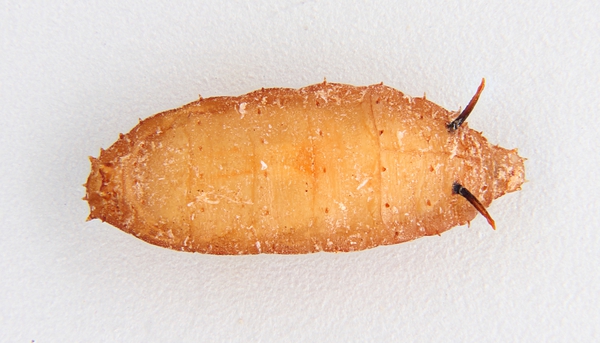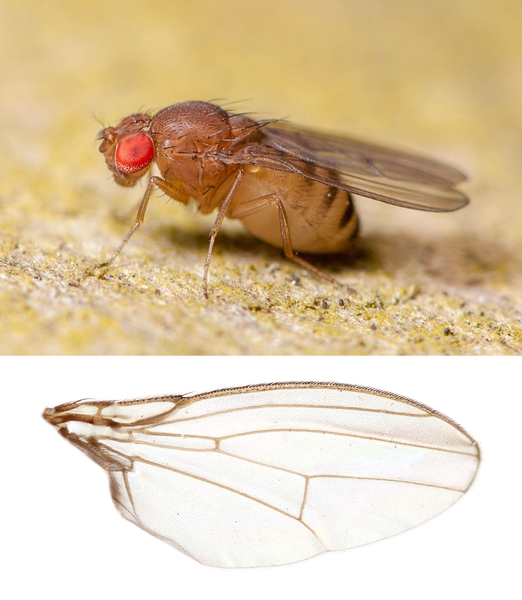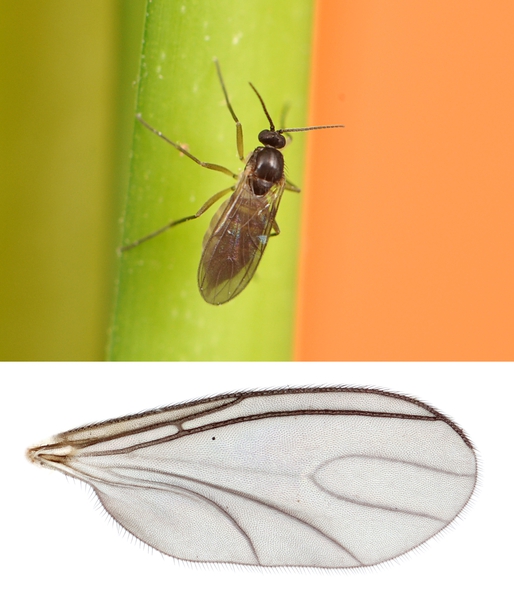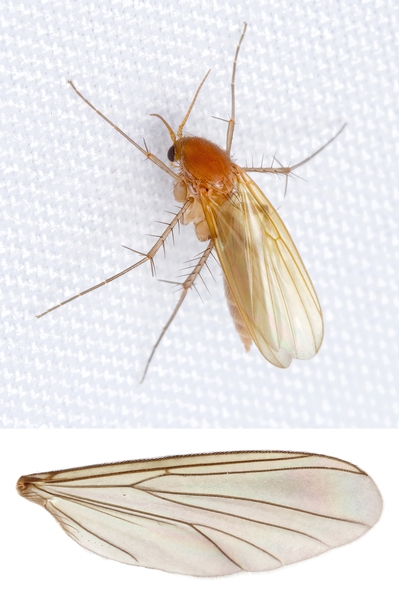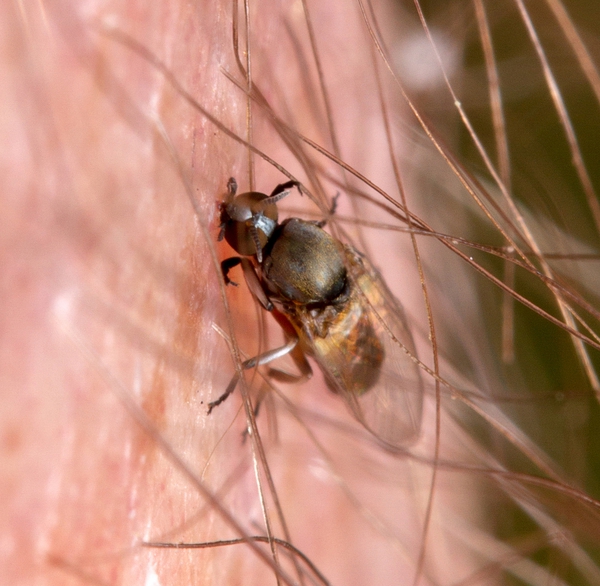Introduction
Phorid flies (also called scuttle, hump-backed, and coffin flies) are small flies (2⁄64-1⁄4” long) that breed in moist, decaying organic matter. Thus, they are often found in and around the home as these breeding sources are abundant in urban environments. The common name of ‘coffin fly’ comes from their tendency to breed in mausoleums and/or other areas where human corpses can be found. They can even breed in coffins underground. Phorid flies are mainly nuisance pests, but there are some cases of larval infestations of human orifices such as the eyes, wounds, and intestines. Additionally, these flies are capable of transmitting bacterial pathogens onto foods or working surfaces in food preparation facilities. However, we emphasize that these instances are fairly rare and the presence of these flies in and around the home is typically only a nuisance to those affected.
Some species of phorid flies are used for biological control because they parasitize fire ants (Pseudacteon spp.), but in this document we only focus on phorid flies that are considered nuisance pests in and around the home.
Identification
The two most common phorid fly species found in and around households are Megaselia scalaris and Dohrniphora cornuta. Descriptions of “phorid flies'' and their identification, biology, behavior, and control will be based on the habits of these species, but note that there are other species of phorid flies that may be encountered in North Carolina. Flies in the family Phoridae range in size and appearance depending on the species in question. Questions on species identification can be directed to our Plant and Disease Insect Clinic.
Phorid flies are colloquially known as “scuttle” flies due to their sporadic movement patterns. Phorid flies opt to run erratically across surfaces rather than flying, which can help distinguish them from other groups of flies. The adults are, on average, 1⁄8" in length with a characteristic hump on the thorax (the area between the head and abdomen) when viewed from the side. They range in colors, often being black, brown, yellow, or a combination thereof. They have short antennae (located on the front of the head) and rather spiky hairs on the face and head (Figure 1 and Figure 2). The back legs of phorid flies are often flat and long in relation to their body size. The easiest way to identify phorid flies, though, is their distinct wing venation; they have heavy veins near the front margin of the wing, with 3-4 parallel veins going across the wing from that area (Figure 3).
Larval phorid flies are not often seen, but pupae may coat surfaces near where the larvae developed. The pupae (puparia) of common phorid flies are oval and slightly flattened, with short spikes and two distinct breathing (respiratory) horns (Figure 4).
Other Similar Flies
Phorid flies are most often confused with fruit flies (Drosophila spp.), however, fruit flies have characteristic red eyes that phorid flies lack (Figure 5). In addition, compared to fruit flies, phorid flies have elongated and expanded hind legs as well as a hump on the thorax. Their wing venation is also different. Phorid flies may also be confused with dark-winged fungus gnats (Family Sciaridae), but dark-winged fungus gnats have long antennae and a distinct “tuning fork” vein in the wing (Figure 6). Similarly, phorid flies are frequently mistaken for common fungus gnats (Family Mycetophilidae) as well, but fungus gnats (like dark-winged fungus gnats) have long antennae and a forked vein on the wings (Figure 7). Finally, phorid flies are occasionally mistaken for black flies (Family Simuliidae), but black flies have longer antennae and do not run around erratically like phorid flies (Figure 8). Black flies are a pest that bite humans and animals while phorid flies do not bite.
Development
Phorid flies go through complete metamorphosis which means that they have an egg, larval, pupal, and adult life stage. The eggs of common household species are somewhat boat-shaped with an average length of 0.5 mm. The eggs are small and difficult to locate. Larvae are cylindrical and vary in color from white, yellow-white, to grey. They resemble the maggots of many other species of flies. Phorid fly larvae can grow up to 10 mm in length and can pupate (move from the larval to pupal life stage) in as few as 55-65 hours. Pupae (Figure 4) are elongate, oval, an average of 4 mm long and complete development in approximately 170 hours. Total developmental time from egg through pupal stages is approximately 10 days, but may be longer in cooler temperatures. The reproductive potential of phorid flies is very high: a female can produce over 700 eggs in her lifetime. Their reproductive potential can make a phorid fly problem difficult to control and you may see a high number of phorid flies emerge at one time even if only a few flies invaded initially.
Habits
Adult phorid flies are frequently found near materials that larvae can feed on. These substrates are composed of moist, decaying, organic matter. Breeding sources may be unsanitary in many cases (such as a leaking sewage pipe), which is how phorid flies may transport pathogenic microorganisms to food materials, mainly in food processing facilities. Larvae have been known to infest wounds of hospital patients and they will also feed on decomposing flesh. The propensity of phorid flies to breed in these materials makes them a public health threat to hospitals, morgues, food-handling facilities and other areas where sanitation is extremely important.
Underneath, in, and around the perimeter of structures, phorid fly larvae may breed in a wide variety of decaying matter that includes pet waste, the lining of drain pipes, the lining of trash receptacles, moist foods that may have dropped between or under appliances, rotting fruits and vegetables, garbage disposals, dirty mop heads, septic systems, potted plants, compost bins, etc. The diversity of acceptable breeding habitat makes pinning down the source of a phorid fly problem difficult. However, it is essential to find the breeding site in order to gain control of an infestation.
Management & Control
As previously stated, the key to phorid fly control is finding and eliminating larval development sites (the areas where adult females lay their eggs). Adult phorid flies can utilize a wide array of habitats for egg laying. They are most abundant around decaying plant and animal matter. Outdoors, be on the lookout for and dispose of sewage-contaminated soil, garbage, moist landscape clippings, decomposing animals, dirty trash receptacles, compost, and other organic materials that hold moisture.
If the problem is most severe in the home (rather than the exterior), it is typically best to begin the search in the kitchen. Look for rotting bags of potatoes, onions, and other stored food products. If no food source is readily apparent, it may be a good idea to inspect plumbing, toilets, and septic tanks. Check areas where moisture exists around plumbing and drains in bathroom and kitchen, crawl space areas, wall voids, and basements where moisture can lead to the presence of fungus. If no obvious source of the infestation is found, a reputable plumbing company should examine drain lines using a flexible scope or smoke to determine whether or not plumbing lines have fractured. The injection of smoke is telling, as the smoke usually follows the path used by adult phorid flies that have entered structures because smoke will escape along foundation expansion cracks or similar openings. If no fractures are present, tape or a clear bowl can be placed over drains to determine whether flies are breeding in biofilms present in the plumbing system. However, unfortunately, the breeding areas for phorid flies can be very difficult to locate. Another complication: keep in mind that phorid flies readily travel over distances. They can wander into structures from outdoor breeding grounds either on or adjacent to the property and adult flies are attracted to light and fly using air currents. Thus, the issue may not originate on the property where adult flies are present.
If phorid flies are a problem in a professional setting such as a mausoleum, hospital, or food handling setting (M. scalaris readily breeds within dead animals and cadavers), we recommend quickly contacting a pest control professional who specializes in the management of structural pests for advice. These breeding sites can harbor thousands of fly larvae due to the presence of copious amounts of organic debris. All small cracks and crevices in these settings need to be inspected and thoroughly cleaned. Treatment is frequently labor intensive.
Sticky fly traps are effective in locating breeding sites. When placed around the structure, they may help discern where breeding activity is heaviest. Treatment can then be more targeted. If organic material within drains is to blame, microbial cleaners that dissolve organic buildup can be effective. Foam delivery is preferred. Bleach and other strong cleaners should NOT be poured down drains because these are noxious products that can dangerously react with other compounds in drain lines. Bleach and standard cleaners will not kill larvae or control phorid flies. Residual liquid pesticides can kill adult flies, but will not eliminate an infestation; the food source for larvae must be identified and removed for best results. If there is a suspected issue with the plumbing under concrete slabs, contact a pest control company for assistance. If there is a break under concrete slabs, the concrete will need to be opened in order to repair broken pipes and all infested soil must be removed. This is typically best executed by a team of professionals. However, as mentioned previously, breeding grounds are most commonly organic debris that can be located through careful inspection and removed.
Publication date: Nov. 17, 2021
N.C. Cooperative Extension prohibits discrimination and harassment regardless of age, color, disability, family and marital status, gender identity, national origin, political beliefs, race, religion, sex (including pregnancy), sexual orientation and veteran status.

